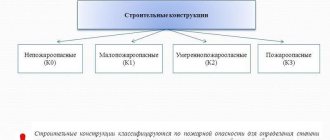Should I do a major renovation in a rented office, production facility or warehouse? This is a complex issue and there are many pros and cons to weigh. One of the important aspects is tax.
When the tenant moves out, he has to pay additional tax based on the residual cost of the repairs, which has not been “depreciated.” The correctness of this position was recently confirmed by the Supreme Court. At the same time, he somewhat softened the approach: he allowed the costs of repairs to be taken into account as expenses if they could be proven to be necessary and useful.
Transfer of Inseparable Improvements
In accordance with Article 623 of the Civil Code, all improvements to the leased property that can be separated from it are the property of the lessee. But if the improvements made cannot be separated without damage to the property, for example, renovation of the premises, then in the event of termination of the lease agreement, the tenant has the right to receive compensation for their cost. Both of these provisions apply unless otherwise provided in the lease agreement. From the foregoing, we can conclude that inseparable improvements to the leased property made by the tenant are the property of the lessor.
Let's consider a situation where the lease agreement stipulates that upon its expiration, the tenant transfers the property to the lessor under a transfer and acceptance certificate. This procedure for returning rental property is common practice. In this case, taking into account the above, the inseparable improvements made by the tenant, together with the property, must be transferred to the tenant under the acceptance certificate.
In accordance with paragraph 1 of Article 39 of the Tax Code, the transfer of inseparable improvements by the user of the property to its owner is recognized as a sale. Thus, this operation falls under VAT on the basis of paragraph 1 of Article 146 and paragraph 2 of Article 154 of the Tax Code. These conclusions are confirmed by judicial practice, for example, the resolution of the FAS of the Volga District dated June 26, 2012 in case No. A65-12909/2011, the resolution of the FAS of the Ural District dated July 1, 2010 No. F09-4941/10-S2 in case No. A07-20648/2009 .
Conclusion: if during the rental period the tenant made inseparable improvements to the property, for example, renovation of the premises, then, upon receiving these improvements, the owner of the premises is obliged to charge VAT on them.
What is the difference between separable improvements and inseparable ones?
The separability and inseparability of improvements depends on whether or not the leased asset will lose its properties if these improvements are withdrawn (Clause 2 of Article 623 of the Civil Code of the Russian Federation).
Accordingly, the difference between separable and inseparable improvements is that the former maintain the performance of the asset, and the latter create new properties and functions for the asset or modernize it. However, not all so simple. From the point of view of an owner who wants to maintain a rental asset in working order, for example, replacing old doors and floors with new ones could well be considered as renovation costs with subsequent capitalization. These expenses are aimed at extending the useful life of the asset, although they do not change its useful area and do not create new characteristics. A similar position was expressed by the Russian Ministry of Finance (letter dated February 29, 2014 No. 07-04-18/01). But it is important to understand that if, after the improvements made, the useful area or volume of the asset changes, then its value as an item of fixed assets should also increase (resolution of the AS of the West Siberian District dated March 18, 2019 No. F04-641/2019 in case No. A46-8255/ 2018).
Thus, according to established practice and the essence of the definition, inseparable improvements are the result of capital work performed by the tenant or contractor, and separable improvements are independent things that can be used separately from the leased property. In other words, this is something that the tenant can take with him without damaging the rental item.
However, judicial precedents on this issue are diverse and unpredictable: when and under what circumstances can inseparable improvements pass to the owner beyond his original decision?
For example, if a tenant installs partitions and air conditioners, but after the termination of the lease agreement decides to remove them, then the court may refuse him this, because they cannot be dismantled without harm to the leased premises (Determination of the Supreme Court of the Russian Federation dated April 10, 2017 No. 309-ES17- 2544).
The issue of separability of objects related to electrical supply and air conditioning systems of buildings is really not so simple. If a tenant installs electrical panels, air conditioning units and a sign in a leased asset that was originally equipped with its own electrical and air conditioning system, then dismantling them will require intervention in the utility systems of the entire building. Therefore, such improvements will be recognized as inseparable (decision of the Supreme Court of the Ulyanovsk region dated May 13, 2016 in case No. A72-16150 /2015, resolution 5AAS dated July 8, 2015 in case A51-27347/2014, decision of the RT Court dated April 14, 2015 in case A65-17489 /2013, resolution of the Federal Antimonopoly Service of the Central District dated 04/07/2011 in case A14-5963/2010).
These types of improvements change the functionality of the rental asset, just like a remodel. For example, if a company leases an asset to house a cafe and adds a toilet for customers with limited mobility or for customers with children to the existing toilets, then such improvements should be considered as inseparable. Of course, after the end of the lease period, it will be possible to disassemble everything and return the premises to its original appearance, but this will require repeated intervention in the communications of the entire building, and the owner of the asset will most likely not take this step.
And even the most ordinary replacement of old double-glazed windows and doors with new ones in a rented premises can become a subject of controversy. At first glance, it appears that these improvements can be separated at the end of the lease without compromising the integrity of the office. However, if windows and doors were considered part of the property before the lease was concluded, then replacing them is simply an upgrade to an integral part of that property. In this regard, it is more logical to consider the replacement of double-glazed windows and doors as inseparable improvements (Resolution of the Presidium of the Supreme Arbitration Court of the Russian Federation dated October 26, 1999 No. 3655/99). Of course, it is possible to appoint an examination to determine whether the improvements are separable, but experts issue opposite conclusions (Resolution of the Federal Antimonopoly Service of the North-Western District dated March 28, 2013 No. F07-314/13 in case No. A42-7628/2011).
In the absence of a single strict algorithm for distinguishing between separable and inseparable improvements, it is necessary in each case to consider the costs incurred on their merits and from the point of view of the presence of consequences for the leased asset: its functions will change or simply be superficially updated.
Redemption of rental property
But what about VAT in a situation where, during the period of validity of the lease agreement, the parties entered into a purchase and sale agreement, and the former tenant became the owner of the property? In this case, on the basis of Articles 425 and 450 of the Civil Code of the Russian Federation, the lease agreement is not considered terminated - there was only a termination of obligations under it by novation. In this case, the original obligation that existed between the parties is replaced by another obligation (Article 414 of the Civil Code of the Russian Federation). In the case under consideration, lease obligations were replaced by obligations under a purchase and sale agreement.
Since the property that was rented became the property of the tenant, it was not transferred back to the lessor under the acceptance certificate. Accordingly, inseparable improvements that were carried out by the former tenant were not transferred. And since they were not transmitted, then their implementation did not take place.
This point of view is confirmed in judicial practice. Thus, in the ruling of the Supreme Arbitration Court of the Russian Federation dated December 9, 2010 No. VAS-14603/10, which was issued in a similar case, the court indicated the following. Once the premises in which an inseparable improvement was carried out became the property of the former tenant under a purchase and sale agreement, then the fact of the implementation of these inseparable improvements, which is subject to VAT, is absent. As a result, the court declared the inspectorate’s decision on the need to levy VAT on this transaction invalid.
In addition, there is a resolution of the Plenum of the Supreme Arbitration Court No. 33 of May 30, 2014, paragraph 26 of which states the following. If capital investments (in our case, inseparable improvements) were not compensated to the tenant and were not made against the rent, the tenant can deduct the tax amounts presented to him on these costs. In this situation, he acts as a person who acquired goods, works or services in the course of his activities.
Thus, for the purposes of VAT, it should be considered that the tenant’s compensated costs for inseparable improvements to the property are transferred to the lessor along with this property, and uncompensated costs and those not made as part of the rent are not subject to transfer to the lessor.
How much taxes will the tenant pay after renovation: BC position
Inseparable improvements in court
In 2005, Metran, a large manufacturer of measuring instruments and metrological instruments (part of Emerson Process Management), leased non-residential premises of the Federal State Unitary Enterprise "Plant Pribor" in Chelyabinsk. Metran made a serious investment: repaired the elevator shaft, updated ventilation, plumbing, lighting, heating, changed windows and decoration. The landlord agreed to the changes, but did not compensate for them in any way. The tenant took into account the improvements as part of depreciable property. Depreciation was accrued on capital investments during the term of lease agreements and was included as an expense when calculating income tax. The lease ended in 2015-2016, when the company launched its own production building. The rented premises were returned to the company. The company took into account the remainder of the cost of inseparable improvements as non-operating expenses.
The tax office conducted an on-site audit of the company and assessed an additional amount of more than 17 million rubles. VAT, as well as income tax. The Federal Tax Service decided: inseparable improvements were transferred free of charge to the lessor. This means that the tenant does not have the right to take into account “under-depreciated” expenses (clause 16 of Article 270 of the Tax Code). In addition, since the repaired property was received by a unitary enterprise, this operation is exempt from VAT under paragraphs. 5 p. 2 art. 146, but there is an obligation to restore the tax in proportion to the residual value of the improvements (clause 2, clause 3, article 170 of the Tax Code). This position of the Federal Tax Service was supported by two authorities.
The Federal Tax Service and the Ministry of Finance adhered to this tough position for many years. Thus, they argued that the return of leased property with under-depreciated improvements is their free sale with the exclusion of the residual value from expenses and the accrual of VAT. In other words, it was impossible to write off the under-depreciated part of the investment as expenses, because it was a “gift” to the lessor. Judicial practice was not uniform. But the vast majority of disputes were resolved in favor of the tax authorities, says Alexey Artyukh, partner at TAXOLOGY TAXOLOGY Federal Rating. Group Tax Consulting and Disputes (Tax Disputes) Group Tax Consulting and Disputes (Tax Consulting) Group Foreign Economic Activities/Customs Law and Currency Regulation, which represented the interests of society in the dispute.
The Arbitration Court of the Ural District canceled the acts of two instances and sided with the taxpayer. In his opinion, there was no gratuitous transfer of improvements, because we are talking about a paid bilateral agreement (lease), where each party had its own benefit.
The tax inspectorate appealed this act to the Supreme Court, and it referred the case for consideration.
Softening the approach
In the Supreme Court, the company relied on the fact that inseparable improvements are not property from an economic and legal point of view, which means that it is physically and legally impossible to transfer them to anyone. Consequently, the application of Articles 146, 170, 270 of the Tax Code is impossible. This cannot be called work in favor of the landlord, lawyers insisted, unless abuses in the relationship between the parties are established, for example, hidden counter-compensation through a reduction in rent.
The position of the Economic Collegium of the Supreme Court, consisting of judges Yuri Ivanenko, Tatyana Zavyalova and Denis Tyutin (ruling No. 309-ES20-16872 in case No. A76-8895/2019) became a compromise for the parties to the dispute.
The Supreme Court concluded that the “under-depreciated” part of the inseparable improvements, which the owner receives without counter-compensation, as a general rule, is not taken into account by the tenant in expenses. It does not meet the criterion of economic justification for expenses (Article 252 of the Tax Code), the Supreme Court believes.
However, the taxpayer can rebut such a presumption of unreasonable expenses. The Supreme Court provides a number of criteria that will help with this.
Inclusion of the “under-depreciated” part of the property in income tax expenses - what needs to be established:
- improvements and expenses for them were necessary for the activities of the taxpayer: “for example, the arrangement of a retail facility in a unique corporate style, the arrangement of communications necessary, first of all, for the operation of the taxpayer’s equipment,” the board gives examples;
- the taxpayer had the intention and ability to recoup costs through the use of the leased property during the lease term;
- the taxpayer had a reasonable and economically justified need to terminate the lease before the useful life of the improvements expired, including if this was due to the fact that the lessee company’s operating conditions had objectively changed.
If through these criteria it cannot be indisputably said that the tenant was interested in the improvements, you can use information about the further fate of the improvements and their significance for the owner: for example, whether the owner dismantled them.
It is reasonable to apply the last test only after assessing the previous criteria, Artyukh believes: otherwise, the fate of the economic justification of the tenant’s expenses will unjustifiably be made completely dependent on how the lessor uses the improvements, which obviously does not correspond to the meaning of Article 252 of the Tax Code on expenses.
Sometimes it is even more profitable to spend money on dismantling improvements so that the landlord does not use them. Then their residual value can be taken into account in expenses, and in addition, VAT can be avoided. In total, the “issue price” reaches 40% of the residual cost of repairs. In some situations, the amount can be quite significant.
Alexey Artyukh, partner at Taxology
The lower courts did not establish the circumstances related to the nature of the improvements, which means that the case should be sent for a new trial at the first instance, the economic board decided.
Evaluation of lawyers
The Supreme Court took a compromise position, not supporting the approach of completely inadmissible taking into account the residual cost of improvements in expenses, lawyers say.
On the one hand, the taxpayer, when determining his tax obligations, will be forced to look at the desires and intentions of his counterparty, notes Alexander Golikov, lawyer, partner at BGP Litigation BGP Litigation Federal Rating. group Arbitration proceedings (major disputes - high market) group International litigation group Pharmaceuticals and healthcare group Compliance group Tax consulting and disputes (Tax consulting) group Family and inheritance law group Antitrust law (including disputes) group Intellectual property (Consulting) group Corporate law /Mergers and acquisitions (high market) group International arbitration group Criminal law group Digital economy group Bankruptcy (including disputes) (high market) TMT group (telecommunications, media and technology) 4th place By revenue 6th place By revenue per lawyer (more than 30 lawyers) 10th place According to the number of Profile lawyers, one of the elements of improvement was the reconstruction of the elevator shaft. A technical or freight elevator can be used to move products or materials, or it can simply stand idle if the premises are rented for an office. It turns out that the value of such an elevator depends on the future tenant of the premises,” Golikov gives an example.
On the other hand, he admits, the motive for introducing numerous tests for the validity of capital investments is an attempt to stop tax evasion schemes by replacing taxable lease payments with the transfer of capital investments without cost recovery. Example: the tenant pays insignificant rental rates compared to the market, and in return repairs the premises and transfers them to the landlord free of charge, while simultaneously including the under-depreciated part in income tax expenses. Artyukh agrees that the criteria proposed by the court are aimed at identifying and suppressing “hidden” remunerative agreements between the parties.
If the taxpayer moves out of the leased premises before the improvements are fully depreciated, and this is almost always the case, then he simply loses the residual value of the expenses.
Evgeny Timofeev, partner, head of tax practice Bryan Cave Leighton Paisner (Russia) LLP Bryan Cave Leighton Paisner (Russia) LLP Federal rating. group Antimonopoly law (including disputes) group Arbitration proceedings (medium and small disputes - mid market) group Foreign trade activities/Customs law and currency regulation group PPP/Infrastructure projects group Land law/Commercial real estate/Construction group Intellectual property (Protection of rights and litigation) group Intellectual property (Consulting) group International arbitration group Tax consulting and disputes (Tax disputes) TMT group (telecommunications, media and technology) group Transport law group Labor and migration law (including disputes) group Digital economy group Bankruptcy (including disputes) (high market) group Compliance group Corporate law/Mergers and acquisitions (high market) group International litigation group Tax consulting and disputes (Tax consulting) group Natural resources/Energy group Family and inheritance law group Criminal law group Pharmaceuticals and healthcare group Financial/Banking law Private Capital group 2nd place By revenue 2nd place By revenue per lawyer (more than 30 lawyers) 5th place By number of lawyers Profile, says Timofeev. “The next step, apparently, will be the recognition of the anti-evasion nature of any tax rule, as well as the recognition of the need to prove the absence of abuse in order to take advantage of any right granted to the taxpayer by the Tax Code,” he notes.
Nevertheless, in general, the approach of the Supreme Court is logical and natural within the framework of the state’s fight against businesses receiving unjustified tax benefits, notes Alexander Golikov.
What should taxpayers do?
Despite the fact that the definition of aircraft is an obvious step forward compared to the previous conservative approach, the proposed criteria by which improvements will be recognized as economically justified are evaluative in nature. Together with the conservatism of tax authorities and courts, this allows us to expect the development of practice and an increase in the number of disputes on specific situations in this area, notes Artyukh. Therefore, taxpayers should now pay attention to the procedure for tax accounting and documentation of inseparable improvements in order to reduce business risks.
What evidence will the taxpayer need?
- the rent does not deviate from the market level due to repairs at the leased property;
- the lessor is not interested in improvements (except for the interest of maintaining his property in a usable condition), including at the stage of written approval of improvements;
- the obvious need for improvements for one’s own activities, taking into account its specifics (in the text of the definition, the design of trading floors is given as an example);
- calculation of the economic efficiency of improvements for doing business using the leased object during the term of the contract.
Alexey Artyukh, Taxology
Artyukh notes that in order to minimize risks, it is necessary to pay attention to the correct qualification of work performed on a leased property as capitalized costs or necessary repairs, as well as the correct determination of the useful life of inseparable improvements. Lawyers do not advise trying to make it maximum: this not only stretches out depreciation payments too much, but also leads to the fact that a significant part of the residual value remains “under-depreciated.”
When services are auxiliary
As part of the dispute, another issue was resolved - about the qualification of the services of a foreign counterparty for the purposes of determining tax obligations. The company entered into an agreement with the related Emerson Process Management Shared Service Ltd for consulting in the field of finance, management, marketing, and personnel management for more than 544 million rubles. – services for companies included in the Emerson Corporation. The company withheld VAT for 80 million rubles. In addition, Emerson provided mail server, WAN maintenance, technical support and other services. It cost 97 million rubles, and the company did not withhold VAT upon payment. The tax authorities considered technical support and similar services auxiliary to consultations, and therefore subject to VAT in Russia (clause 3 of Article 148 of the Tax Code). The company had to withhold 17.3 million rubles. VAT, the Federal Tax Service decided.
The Supreme Court agreed with this. “The court correctly pointed out that before asking about the types of services, it is necessary to understand whether some of them are auxiliary to others. If the answer is positive, auxiliary ones have the same regime as the main ones, and only the type of basic services needs to be established,” says Evgeny Timofeev.
The disadvantage, in his opinion, is that the court reduced the very question of the relationship between the types of services only to whether some services can be obtained without others. “If they cannot be obtained separately, the question should be raised as to whether it was possible to purchase similar supposedly auxiliary services from third parties, taking into account the specific parameters of the supposedly basic services, up to technical compatibility,” Timofeev believes. If such an acquisition is possible, he says, the services cannot be considered ancillary, even if they are purchased from the same supplier in a single package.
- Irina Kondratyeva
- Economy Board of the Armed Forces
Conclusion
Since the purchase of the leased property took place during the validity period of the lease agreement, we come to the conclusion that the uncompensated inseparable improvements were not transferred to the lessor. That is, in accordance with Article 39 of the Tax Code of the Russian Federation, there was no sale, and accordingly there is no object of VAT taxation.
Taking into account the above provisions of the law and judicial practice, we can draw the following conclusion. If the property was purchased by the tenant during the validity period of the lease agreement, then VAT should not be charged on inseparable improvements made by him earlier, but not transferred to the lessor.
Accounting and tax accounting of inseparable improvements to leased property
Can the tenant register a fire alarm costing 98,691 rubles as part of fixed assets and write off its cost in accounting during the lease period - 11 months? Is it possible to immediately write off its cost as material expenses in tax accounting? The landlord agrees to inseparable improvements; the costs will not be compensated.
Fedik Inna Leontievna, expert in accounting, tax and management accounting of the reference and legal service Kontur.Normative
Position of the courts
However, in reality everything turns out to be not so simple. Accounting practice is full of disputes both between tenants and landlords, and between business entities and tax authorities regarding the classification of improvements as one type or another. The judiciary, in turn, has its own position. Therefore, I propose to examine some controversial cases in which types of construction work were recognized by the court as repair work. For example, renovating office premises. In accordance with clause 5 of Appendix No. 7 to the Rules and Standards for the Technical Operation of the Housing Stock, approved by Decree of the State Construction Committee of Russia dated September 27, 2003 No. 170, the replacement and restoration of individual elements (devices) and door fillings refers to routine repairs. Accordingly, if the work carried out on the leased property is classified as repairs, then the tenant takes it into account as operating expenses.
Or consider landscaping a road section. In the Resolution of the Federal Antimonopoly Service of the Ural District dated May 14, 2008 No. Ф09-3351/08-С3 for JSC Concern Kalina, the court came to the conclusion that the work performed (soil compaction, crushed stone preparation, bitumen pouring, curbing driveways, laying asphalt, paving sites on the main thoroughfares) did not change the technological or service purpose of the road section and did not increase its technical and economic indicators. The work was carried out to maintain roads on the internal territory of the organization in proper condition, therefore, they are repair work.
“Only work on the completion, retrofitting, modernization, reconstruction or technical re-equipment of an object can be recognized as inseparable improvements. »
Third example. In the Resolution of the Federal Antimonopoly Service of the North Caucasus District dated June 18, 2009 No. A53-14011/2008-C5-14 for Cherkizovo-Don LLC, representatives of the tax authority classified the installation and configuration of an office PBX and local computer network as inseparable improvements to fixed assets leased by the company and in in accordance with paragraph. 4 paragraphs 1 art. 256 of the Tax Code of the Russian Federation was considered depreciable property. The court did not support this position and indicated that the tax authority did not provide evidence confirming the fact of the non-separability of the improvements made during the installation and configuration of the equipment.
There were also a number of situations in which judges took the side of taxpayers and concluded that the types of work carried out were specifically repair work.
- Laying brick partitions, plastering and wall cladding, plastering wooden slopes, lining with European laths, leveling the floor, installing a cement screed, dismantling lamps in the building (Resolution of the Federal Antimonopoly Service of the Russian Federation dated July 10, 2007 No. A43-25348/2006-31-814).
- Replacement of old floors, worn-out sewer pipes and water supply pipes, window blocks, painting of walls, ceilings, door blocks (Resolutions of the Federal Antimonopoly Service of Ukraine dated May 22, 2007 No. F09-3656/07-S2, FAS ZSO dated September 25, 2006 No. F04-6044/2006 (26466-A81-31)).
- Replacement of the door along with the door frame (opening in the wall), installation of an additional brick partition and an additional metal partition for one office workplace. According to the Resolution of the Federal Antimonopoly Service of the Moscow Region dated January 18, 2007 No. KA-A40/13128-06-2, the repair work carried out did not cause a change in the technological or service purpose of the building and its premises.
Accounting entries provided that the improvements made are agreed upon with the lessor
D 08...K 60 - Inseparable improvements were made D 19...K 90 - VAT on inseparable improvements D 68...K 19 - VAT was accepted for deduction D 01...K 08 - Inseparable improvements were taken into account D 26...K 02 - Depreciation was calculated on inseparable improvements.
The amount of accrued depreciation is also recognized when calculating income tax. Two options for transferring inseparable improvements to the lessor
- At the end of the lease agreement, inseparable improvements as part of the leased property are transferred to the lessor, the lessor does not reimburse the cost of inseparable improvements: D 02...K 01 - Formation of the residual value of transferred inseparable improvements (the amount of accrued depreciation is written off to reduce the initial cost of inseparable improvements) D 91...K 01 - The residual value of inseparable improvements was written off as other expenses D 91...K 68/VAT - VAT was accrued on the cost of gratuitously transferred inseparable improvements D 99...K 68/Income Tax - PNO was accrued on the residual value of inseparable improvements (not recognized when calculating income tax ).
- At the end of the lease agreement, inseparable improvements as part of the leased object are transferred to the lessor, the lessor reimburses the cost of inseparable improvements: under this condition, the amount of depreciation accrued from the cost of inseparable improvements is not recognized as an expense when calculating income tax. D 76...K 91 - Cost of compensation for inseparable improvements D 91...K 68/VAT - VAT accrued D 91...K 01 - The residual value of inseparable improvements is written off.
It should be borne in mind that redevelopment is an element of both reconstruction and major repairs; it in itself does not determine the nature of the work performed. If, as a result of redevelopment, the technical and economic indicators and functional purpose of the premises have not changed, work to increase the volume of the building (superstructure, extension) has not been carried out, then the redevelopment is recognized as a major overhaul (Resolution of the Federal Antimonopoly Service of Ukraine dated November 28, 2006 No. F09-10509/06- C7).
- Repair of local and telephone networks (Resolution of the Federal Antimonopoly Service NWO dated May 14, 2007 No. A56-15769/2006).
- Installation of ventilation equipment and a thermal curtain (Resolution of the Federal Antimonopoly Service VSO dated June 29, 2007 No. A74-3968/06-F02-3757/07).
- Repair of electrical networks and electrical equipment, installation of air ducts in repair shops (Resolution of the Federal Antimonopoly Service of the North-West District dated July 14, 2005 No. A21-8680/04-C1).
- Replacement of equipment for an integrated security system and fire alarm system (Resolution of the Federal Antimonopoly Service of the Moscow Region dated January 24, 2007 No. KA-A40/13476-06).
- Repair work on internal roads. The judges of the Federal Antimonopoly Service (Resolution No. A68-AP-84/14-05-317/Ya-05-1006/10-05 dated February 20, 2007) supported the taxpayer on a controversial issue, since there was evidence that the work performed changed the quality characteristics of the objects or were carried out under a special reconstruction project, the tax authority did not submit.
- Major repairs of a brick fence (partial replacement of pillars, partial strengthening of the foundation of the fence, new masonry of part of the walls of the fence for a total length of 104.4 m, which is 10% of the total length of the fence (Resolution of the Federal Antimonopoly Service of the North-West District dated August 29, 2005 No. A56-50335/2004)) .
- Repair of external water supply and cable replacement. The judges of the Federal Antimonopoly Service NWO (Resolution No. A56-4658/05 dated 07.07.2005), having collectively assessed the documents available in the case and the evidence presented, rightfully recognized that the costs of repairing the external water supply system and replacing the cable are not capital in nature, but are current costs to maintain equipment in working condition.
It is not possible to write off a one-time charge in tax accounting.
Expenses were incurred by the tenant in the form of inseparable improvements to fixed assets with the consent of the lessor, which means that for tax accounting purposes this investment is depreciable property (it does not matter that the cost of the system is less than 100,000 rubles), and its cost is taken into account through the depreciation mechanism (paragraph 4, paragraph. 1 Article 256 of the Tax Code of the Russian Federation).
In general, depreciation for permanent improvements is calculated based on the useful life of the leased property. However, despite the fact that the fire alarm in our example is an inseparable object, according to the classification of fixed assets it is a separate accounting object and has its own service life, which differs from the service life of the building. Consequently, its depreciation is calculated based on its useful life, determined in accordance with the classification of fixed assets.
Fire alarm systems belong to depreciation group VI (useful life over 10 years to 15 years inclusive), OKOF code 330.26.30.50 “Security or fire alarm devices and similar equipment.”
For additional information, see the article “Return of property by the tenant, document flow and accounting.” In particular, it is useful to know that if, when returning the leased property along with improvements, the lessor does not reimburse the cost of these improvements, then in the lessee’s accounting their transfer is considered as gratuitous.
Get free access to the legal reference service and ask your question to an expert.
Get access






